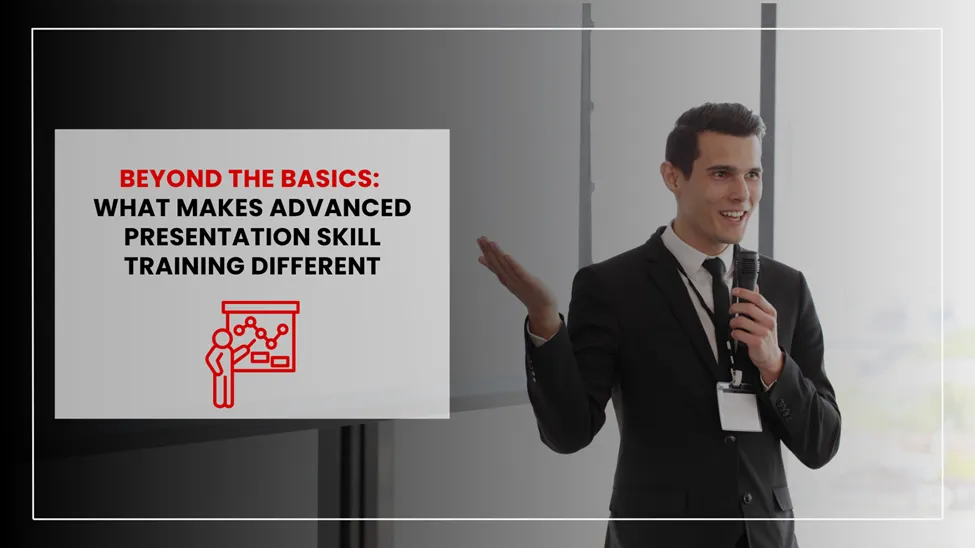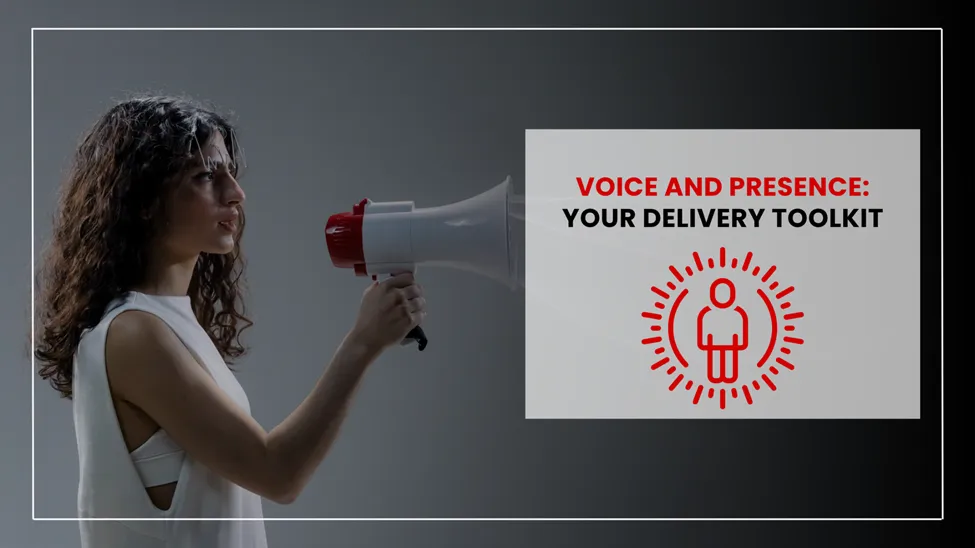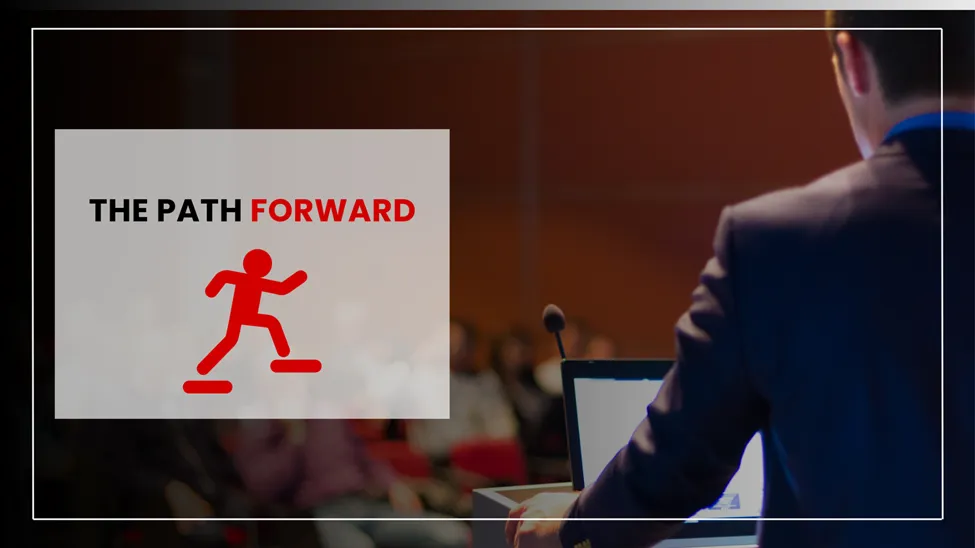Advanced Techniques in Presentation Skill Training: Beyond the Basics
Ever watch someone command a room with seemingly effortless charisma during a presentation and think, “I wish I could do that”?
Here’s a little secret: they weren’t born that way. Those presentation superstars you admire? They’ve mastered advanced techniques that anyone can learn with the right training. The distance between a forgettable presentation and one that leaves your audience buzzing isn’t talent—it’s technique.
When “Good Enough” Isn’t Good Enough Anymore

Let’s be honest. Most workplace presentations are mediocre at best. The speaker mumbles through slides, the audience checks their phones, and everyone breathes a sigh of relief when it’s over. If that sounds familiar, you’re not alone.
But in today’s competitive business landscape, just “getting through it” won’t cut it anymore. Whether you’re pitching to investors, leading your team, or speaking at an industry conference, your presentation skills directly impact your success rate.
Think about it: How many brilliant ideas have died because they were poorly presented? How many promotions have gone to the person who could better articulate their value?
Beyond the Basics: What Makes Advanced Presentation Skill Training Different

Basic presentation training teaches you the fundamentals—make eye contact, speak clearly, don’t read from your slides. That’s like learning to play “Chopsticks” on the piano. Advanced presentation skill training is the difference between “Chopsticks” and Chopin.
Advanced training digs deeper into the psychology of influence and the art of audience engagement. It’s where presentation skills training transforms from simple communication tips into reputation-building, career-advancing mastery.
The Psychological Edge
The most persuasive presenters understand something fundamental: presentations aren’t about slides—they’re about emotions. Advanced training on presentation skills teaches you to:
- Create moments of genuine connection with your audience
- Build trust rapidly through micro-behaviors
- Use strategic vulnerability to increase your authority (counterintuitive but powerful!)
- Implement cognitive framing techniques that make your ideas stick
One executive I worked with doubled her team’s project approval rate after applying these psychological principles. “I’m presenting the same information,” she told me, “but now people actually hear it.”
Advanced Structure: The Hidden Architecture of Memorable Presentations
Ever noticed how some presentations feel random while others seem to flow naturally from one point to the next? That’s not an accident—it’s architecture.
The best presentation skills training programs teach you to structure your content for maximum impact:
- The Hook: Advanced presenters never start with “Today I’ll be talking about…” Instead, they create pattern interrupts that snap the audience to attention.
- The Story Spine: Rather than listing points, they create a narrative flow with tension and resolution.
- Strategic Repetition: They know exactly which points to repeat and when—the difference between annoying redundancy and powerful reinforcement.
- The Resonant Close: Instead of ending with a weak “Any questions?”, they craft closings that inspire action.
Voice and Presence: Your Delivery Toolkit

Your voice is an instrument, and most people use about 10% of its capabilities. Advanced training presentation skill workshops teach you to access your full vocal range:
- Dynamic variation: Using volume, pace, and tone as persuasive tools
- Strategic pausing: Creating tension and emphasis through silence
- Vocal authority: Eliminating uptalk and vocal fry that undermine credibility
- Emotional congruence: Matching your voice to your message
But delivery goes beyond voice. Your physical presence communicates volumes before you say a word. Advanced training teaches you:
- Purposeful movement: Using the stage strategically rather than pacing nervously
- Gesture psychology: Hand movements that reinforce rather than distract
- Power positioning: Where to stand for maximum authority
- Micro-expressions: Controlling the subtle facial cues that build trust
The Art of Visual Support

PowerPoint has killed more presentations than stage fright. Advanced presentation skill training doesn’t just teach you how to make prettier slides—it fundamentally changes how you think about visual support.
The masters know that slides should never be your presentation’s main event. Instead, they’re visual punctuation marks that emphasize your most important points.
Advanced training teaches you to:
- Create slides that support rather than compete with your message
- Use visual hierarchy to direct audience attention
- Implement the “one idea, one slide” principle effectively
- Harness the power of simplicity and white space
Real-Time Adaptability: Reading and Responding to Your Audience
Amateur presenters deliver the same presentation regardless of audience response. Advanced presenters constantly adapt in real-time.
Through sophisticated presentation skills training, you’ll learn to:
- Identify the subtle signs of audience confusion, boredom, or resistance
- Employ “rescue techniques” to recapture wandering attention
- Pivot your content based on in-the-moment feedback
- Turn hostile questions into opportunities for connection
I once watched a trainer save a workshop that was heading south by completely changing her approach mid-presentation based on the audience’s energy shift. That’s not luck—it’s an advanced skill.
The Rehearsal Revolution
How you practice matters more than how much you practice. Advanced training on presentation skills introduces sophisticated rehearsal techniques that maximize improvement:
- Sectional practice: Breaking your presentation into manageable chunks
- Video analysis: Using specific criteria to evaluate your performance
- Deliberate skill isolation: Focusing on one technique at a time
- Progressive stress exposure: Gradually increasing performance pressure
One client reduced her preparation time by 60% while improving her delivery by using these targeted rehearsal methods.
From Information to Transformation
The greatest presenters don’t just inform—they transform. They leave their audiences changed in some fundamental way.
Advanced presentation skill training teaches you to:
- Create moments of insight rather than just delivering information
- Use strategic emotion to make your message unforgettable
- Craft calls to action that drive behavior change
- Build presentations that continue working long after you’ve finished speaking
Making the Investment
Let’s be clear: developing advanced presentation skills requires investment—of time, effort, and often money for quality training. But few professional investments deliver higher returns.
Consider:
- A single successful pitch can return your training investment a hundredfold
- Leadership roles increasingly go to those who can articulate a vision compellingly
- The ability to present powerfully sets you apart in nearly every professional field
The Path Forward

Advanced presentation skill training isn’t about becoming someone you’re not. It’s about becoming the most effective version of yourself.
It’s not hard to progress from good to outstanding, as long as you stick to mastering techniques that are above the standard. You need to train alongside those who know how science and psychology affect strong presentations, not just average advice.
When you’re ready to transform your professional presence and multiply your impact, advanced presentation skills training isn’t just a nice-to-have—it’s essential.
Ready to leave “just okay” presentations behind and step into true communication mastery? The journey begins with a decision to move beyond the basics and embrace the advanced techniques that separate the forgettable from the unforgettable.
